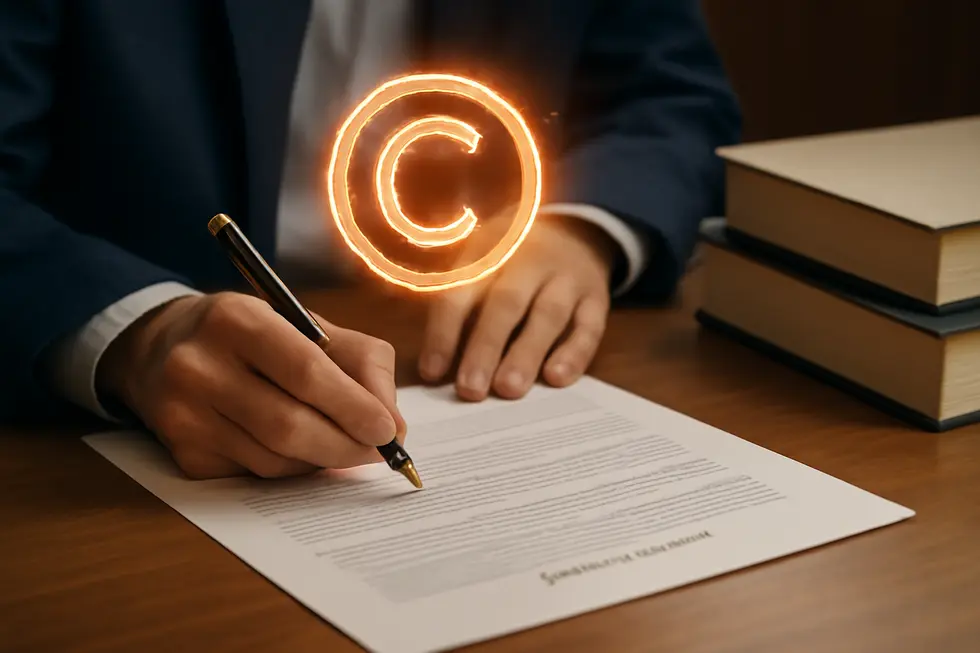Introduction
Understanding the concept of agreement copyright is essential for business owners who regularly engage in contracts and publishing agreements. Agreements, often viewed as simple legal papers, can contain original language eligible for copyright protection. Moreover, the way copyrights are managed through these agreements—especially in publishing—can greatly impact your control over intellectual property and business assets. This guide demystifies agreement copyright by explaining its status, its pivotal role in publishing agreements, and practical considerations for managing contractual rights. Through three focused chapters, you’ll gain clarity on how agreement copyrights influence your business contracts, how publishing agreements affect author and business rights, and which resources and strategies can help you make informed decisions to protect and negotiate your rights effectively.
Tables of Contents
Chapter 1: The Copyright Status of Agreements and the Concept of Agreement Copyright
- Navigating Legal and Technological Factors Shaping Agreement Copyright
- Navigating Economic Control and Contractual Rights in Agreement Copyright
- Balancing Rights and Access: Societal and Practical Dimensions of Agreement Copyright
Chapter 2: The Role of Agreement Copyright in Publishing Agreements and Author Rights
- Navigating Copyright Transfer: Balancing Author Rights and Publisher Control in Publishing Agreements
- How Licensing Agreements Shape the Balance of Rights Between Authors and Publishers
- Navigating Copyright Transfers and Licensing: Legal and Strategic Insights for Authors
Chapter 3: Key Considerations and Resources Regarding Agreement Copyright in Contractual Rights Management
- Clarifying the Boundaries: Defining Scope and Rights Transfer in Copyright Agreements
- Optimizing Contract Lifecycle Management to Safeguard Copyrights in Agreements
- Integrating Legal Principles and Technological Tools for Effective Copyright Management in Contracts
Chapter 1: The Copyright Status of Agreements and the Concept of Agreement Copyright

1. Navigating Legal and Technological Factors Shaping Agreement Copyright
The copyright status of agreements is shaped by an interplay of legal principles and advancing technology that govern the rights to creative works. Legally, copyright license agreements are binding contracts that define how a copyrighted work may be used, transferred, or adapted. These agreements clarify who holds authorship versus ownership and specify the conditions under which derivative works can be created, addressing the need to balance creators’ exclusive rights with exceptions such as fair use and accessibility mandates under international treaties. With evolving technology, agreements must now anticipate new forms of derivative works, including software adaptations and artificial intelligence-generated content. To complement legal measures, digital rights management (DRM) tools are often employed within agreements to enforce permissions through technological means. This dual approach—integrating legal frameworks with digital enforcement—ensures creators retain control while enabling lawful use in a rapidly changing landscape. Understanding this nexus is essential, as it provides a robust architecture for managing copyrights effectively and adapting contracts to emerging challenges. For further insights into the legal foundation of copyright agreements, consult detailed resources on the basics of copyright law in business contexts.
2. Navigating Economic Control and Contractual Rights in Agreement Copyright
Understanding the economic and contractual implications of agreement copyright is crucial for managing intellectual property effectively. Copyright ownership starts with the author but is often transferred or licensed through contracts to other entities like publishers. This transfer determines who holds the exclusive rights to reproduce, distribute, or publicly display the work, shaping revenue streams through royalties or fees. Licensing agreements vary, ranging from exclusive rights that grant sole use of the copyrighted work, often commanding higher economic returns, to nonexclusive licenses that permit multiple users simultaneously. The duration and scope set forth in contracts define how long these rights last, impacting how long licensees can commercially exploit the work before rights revert to the original owner or expire. Moreover, enforcement rights embedded in agreements empower copyright holders to act against unauthorized usage via legal tools, including termination clauses that protect both parties from breaches or nonpayment. The clear delineation of financial benefits within such agreements protects creative works from unauthorized exploitation, ensuring creators and licensees retain economic value. For authors and rights holders, grasping these contractual dynamics is essential to maintain control and safeguard income. Additional details on structuring effective copyright ownership and licensing agreements can be found in A Guide to Copyright Licensing. For insights on managing author rights and publication terms, exploring resources like the comprehensive copyright protection overview can be extremely valuable.
3. Balancing Rights and Access: Societal and Practical Dimensions of Agreement Copyright
The copyright status of agreements and the concept of agreement copyright reflect nuanced societal and practical dynamics in managing creative works. Practically, agreements such as copyright licenses serve as legal contracts clarifying how copyrighted materials can be lawfully used. They specify boundaries like permitted uses, duration, and compensation, enabling creators to maintain control while allowing others access under defined terms. These contracts themselves are not typically copyrighted as original works but are crucial in regulating rights transfer and use.
From a societal perspective, copyright law carefully balances the creator’s exclusive rights—including economic and moral rights—with the public’s interest in cultural enrichment. Agreements embody this balance by formalizing how rights are shared or retained without undermining the author’s fundamental ownership. Understanding the distinction between authorship, who holds moral rights, and ownership, which holds economic rights, is key to grasping how these contracts function.
Thus, agreement copyrights exist less as a distinct copyright in the contract text and more as a framework supporting equitable use and protection. This delicate interplay fosters innovation and cultural dissemination while respecting creators’ dignity and legal rights. For deeper insights on licensing and moral rights, see this external resource. Additionally, explore the nuances of copyright protection for creative works in business at copyright protection for books, movies, and songs.
Chapter 2: The Role of Agreement Copyright in Publishing Agreements and Author Rights

1. Navigating Copyright Transfer: Balancing Author Rights and Publisher Control in Publishing Agreements
Agreement copyright significantly shapes how authors’ rights evolve once they enter into publishing agreements. Most often, authors either transfer their full copyright ownership to a publisher or grant a license to use their work. In a copyright transfer, the author conveys all rights to the publisher, including reproduction, distribution, and derivative works. This transfer profoundly limits an author’s ability to reuse or share their work without the publisher’s consent. Conversely, a copyright license allows publishers to use the work under specific terms without surrendering ownership. Licenses may be exclusive—granting sole exploitation rights to the publisher—or non-exclusive, permitting the author to retain use and licensing rights elsewhere. These distinctions directly impact author control; retained rights might include posting the work on personal sites, creating teaching materials, or allowing translations. Authors can negotiate to preserve such privileges by adjusting contract terms or using author addenda. Additionally, copyright law provides a mechanism to reclaim rights after a statutory period, typically 35 years post-transfer, offering a path to regain control. Open access publishing further shifts this dynamic by favoring licensing over transfers and encouraging broader sharing under Creative Commons terms. Understanding these nuances is crucial for authors aiming to protect their interests and maintain influence over their published works. For deeper insights into contract provisions and rights negotiation, refer to the University of Texas at San Antonio’s scholarly publishing contracts resource.
2. How Licensing Agreements Shape the Balance of Rights Between Authors and Publishers
Licensing arrangements are at the heart of agreement copyright in publishing, determining how rights are divided and exercised between authors and publishers. Unlike full copyright transfers, licensing allows authors to selectively grant publishers the rights to publish, distribute, or otherwise exploit a work while retaining other rights, such as using the work for teaching or future projects. This nuanced allocation, often called “unbundling” rights, enables authors to maintain ongoing control and reuse options.
The scope, duration, and exclusivity of licensed rights define the practical relationship between the author and publisher. Traditional agreements might transfer exclusive ownership, enabling publishers to oversee promotion and royalties, but many modern contracts favor non-exclusive licenses, allowing authors to share or republish their work elsewhere.
Moreover, copyright law offers authors the ability to reclaim rights after a statutory period, typically around 35 years, providing a legal pathway to renegotiate or reclaim control. Understanding these licensing frameworks equips authors to protect their interests effectively while granting publishers the necessary permissions to disseminate their works.
For authors navigating these complexities, tools like the SPARC Author’s Addendum provide valuable guidance on retaining rights within agreements. For more insight into negotiating and understanding publishing contracts, university library resources offer comprehensive guidance on managing your copyright and licensing choices within publishing agreements. Learn more here.
Additionally, understanding the broader context of copyright protection in creative works, including books and scholarly publications, can be enhanced through detailed resources such as copyright protection for books, movies, and songs.
3. Navigating Copyright Transfers and Licensing: Legal and Strategic Insights for Authors
Navigating Copyright Transfers and Licensing: Legal and Strategic Insights for Authors
Publishing agreements fundamentally shape an author’s control over their creative work. These agreements typically require authors to either transfer full copyright ownership or grant a license to the publisher. Full copyright transfer means the author relinquishes exclusive rights such as reproduction, distribution, and derivative works, limiting future independent use. Conversely, licensing—especially non-exclusive licenses—allows authors to retain ownership while permitting the publisher to publish and distribute the work. This distinction is crucial, as the scope of rights granted affects how authors can reuse or share their content later.
Authors should strategically negotiate publishing contracts to preserve key rights, such as the ability to share their work in educational contexts or deposit it in digital archives. Utilizing author addenda can clarify and protect retained rights not covered in standard agreements. Understanding that copyright arises automatically upon creation but that publishers only need a license to publish empowers authors to avoid unnecessarily transferring full ownership. The opportunity to maintain control over one’s intellectual property depends on awareness of legal nuances and proactive contract negotiation.
For further insights on protecting your rights when publishing, consult expert guidance from university scholarly communication offices and explore resources on copyright protection for books, movies, and songs.
Chapter 3: Key Considerations and Resources Regarding Agreement Copyright in Contractual Rights Management

1. Clarifying the Boundaries: Defining Scope and Rights Transfer in Copyright Agreements
Defining the scope and transfer of rights in copyright agreements is fundamental to effective contractual rights management. The agreement must clearly specify which rights are granted or assigned, including the geographic territory, duration, media formats, and permitted uses. This precise delineation ensures all parties understand the boundaries of intellectual property exploitation and prevents disputes.
Assignments require explicit articulation of the copyrighted work involved, which rights are transferred, and any conditions tied to reversion or retention by the assignor. Licenses may be exclusive or nonexclusive, affecting the degree of control the copyright holder retains. Duration may be limited, perpetual, or conditional, all of which influence how the work can be commercially or noncommercially used.
Compensation terms must be clear, whether through royalties or flat fees, aligning financial expectations with rights granted. Careful crafting of these provisions protects the original creator’s interests while enabling assignees or licensees to exercise granted rights confidently.
This nuanced approach balances legal clarity with business realities, highlighting why authors and rights holders should thoroughly review and negotiate agreements. For a deeper understanding of these contract structures and best practices in rights delineation, Aaron Hall’s authoritative insights offer essential guidance.
2. Optimizing Contract Lifecycle Management to Safeguard Copyrights in Agreements
Contract Lifecycle Management (CLM) plays a critical role in protecting and managing copyrights within contractual rights frameworks. From the contract’s inception through negotiation, execution, and eventual renewal or termination, CLM ensures that intellectual property rights are clearly articulated and upheld. Effective CLM requires precise definitions of copyrighted materials involved, detailing the scope of permitted uses and any geographical or temporal limitations. This clarity prevents misunderstandings and safeguards against unauthorized exploitation. Moreover, well-structured royalty and payment terms embedded in the contract guarantee that creators receive fair compensation while enabling licensors to monitor compliance and audit reporting accurately. Confidentiality clauses protect sensitive information tied to copyrighted works, adding another protective layer. Leveraging automated CLM systems enhances compliance by tracking deadlines and renewal conditions, thus minimizing risks of infringement or missed financial obligations. Centralizing contract data ensures streamlined workflows and secure document management throughout the contract’s lifecycle. For authors and organizations seeking to understand or negotiate publishing and licensing agreements, specialized resources offer invaluable guidance on balancing rights retention with the granting of publication permissions. Comprehensive insights and best practices are available that illuminate how to integrate copyright provisions seamlessly into contract management. For further detailed guidance on licensing agreements and copyright management, see this resource from Volody. Additionally, expanding knowledge on copyright protections can be enhanced by exploring practical articles about copyright protection for books, movies, and songs.
3. Integrating Legal Principles and Technological Tools for Effective Copyright Management in Contracts
Understanding and managing copyright within agreements requires harmonizing legal insights with modern technological capabilities. Copyright protection applies to contracts only when they demonstrate originality beyond standard template language, emphasizing the importance of uniquely drafted terms. Licensing agreements concerning intellectual property must explicitly outline the scope of rights granted, payment structures, confidentiality, and termination conditions to safeguard stakeholders’ interests. Negotiating terms—such as converting exclusive rights to non-exclusive licenses or retaining specific author uses—is facilitated through tools like author addenda, enhancing control over creative work rights. Technology plays a pivotal role by offering contract management platforms that centralize documents, enforce version control, and streamline monitoring of compliance and deadlines. While copyright governs reproduction rights, contracts may also include data protection clauses addressing trade secrets and privacy—distinct legal areas that complement but do not override copyright law. By combining thorough legal frameworks with advanced contract management systems, parties ensure clarity, enforceability, and strategic retention of rights within publishing and licensing agreements. For authors navigating these complexities, resources like detailed publishing contract guides provide valuable negotiation strategies and rights retention options. For further detailed legal understanding about originality requirements in contracts, see UpCounsel’s expert article on contract copyright nuances here. Additionally, exploring best practices for intellectual property licensing agreements can be found in comprehensive overviews specialized on contract drafting and management.
Considerações finais
Navigating the nuanced landscape of agreement copyright is vital for business owners who rely on contracts, publishing agreements, or intellectual property collaborations. Recognizing that contracts can hold original language protected by copyright empowers businesses to treat their agreements as valuable assets, not just paperwork. Understanding the evolving dynamics of publishing agreements and how copyrights are licensed or transferred equips owners with greater control over authored work and collaborative content. Moreover, the ability to evaluate, negotiate, and manage contractual rights through available resources ensures that agreements work in your favor, protecting your interests and fostering sustainable business practices. With this informed perspective, you can approach agreements confidently, knowing how to safeguard your creative and legal position in any deal.
Get your trademark today! Thousands have protected their brand by filing a trademark. What are you waiting for? Start your trademark application now!
Sobre nós
The globe’s top website for registering trademarks and safeguarding your brand, name, logo, or slogan. We provide streamlined, expert-backed services that empower business owners to protect their intellectual property efficiently and confidently.






